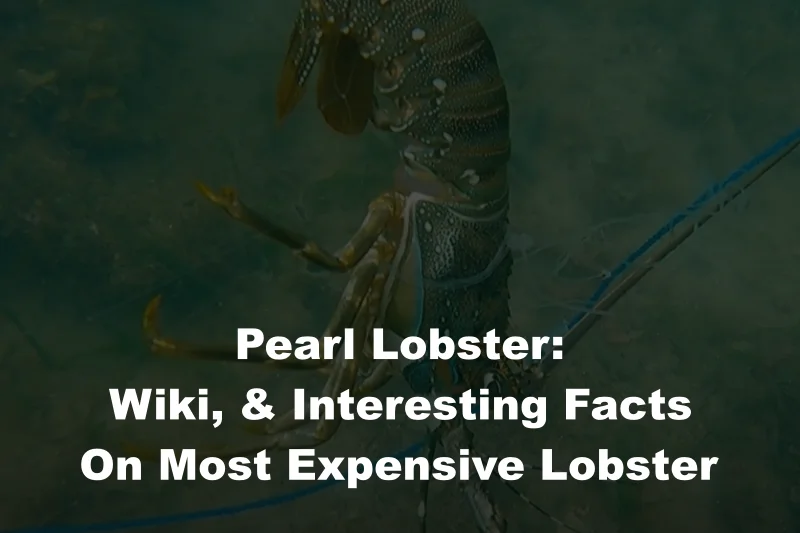The vast, edible spiny lobster Panulirus ornatus (also known as the tropical rock lobster, ornate rock lobster, ornate spiny lobster, and ornate tropical rock lobster) has been successfully produced in captivity and goes through 11 distinct phases of larval development.
The ornate rock lobster stands out because of its large, blue-green shell. It has big horns that stick out from the top of its head and stripes and dots of different colors all over its body. It looks like a spider because its walking legs have complicated striped patterns.
Pearl or tropical rock lobsters are among the rarest and most expensive lobsters. The larvae of these beautiful crustaceans are so highly sought after that they have been the target of international smuggling operations.
This article will introduce the reader to the pearl lobster, Panulirus ornatus, commonly known as the tropical rock lobster, and list ten intriguing facts about this creature. Hence, without further ado, let us begin our topic.
Pearl Lobster: Wiki
| Scientific Name | Panulirus ornatus |
| Common Name | Tropical rock lobster, Ornate rock lobster, Ornate spiny lobster, Ornate tropical rock lobster, and Pearl Lobster |
| Size | They can reach a length of 30–40 centimeters (12–16 inches) and a weight of 500–1 kilogram (1 to 2 pounds). However, certain species can grow to over 4 kilos in weight and 60 centimeters in length (9 pounds). |
| Habitat | From the western Red Sea and KwaZulu-Natal to eastern Japan and Fiji, the range of Panulirus ornatus is extensive in the Indo-Pacific. |
| Diet | Eats invertebrates, including small crustaceans, gastropods, and bivalves. Many lobster species rely on a crustacean diet. |
| Predators | Sharks, Eels, Octopuses, Groupers, Sea Birds, and Humans. |
| Colors | Have a Variety of colors depending on their species, habitat, and age. The colors are Black, Green, Red, Blue, and Yellow. |
| Weight | Weight of 500–1 kilogram (1 to 2 pounds) while some species have over 4 kilos of weight. |
| Life Span | Depending on the species, tropical rock lobsters can live anywhere from 20-30 years in the wild. It has been documented that some species can survive for 50 years or more. |
| Price | The price per kilogram for farmed pearl lobsters is around $50, whereas wild-caught pearl lobsters fetch $99. |
| About It | The Panulirus ornatus, or tropical rock lobster(Pear Lobster), has been successfully reared in captivity and undergoes 11 distinct stages of larval development. Its blue-green carapace is marked with various colored stripes and spots, and its walking legs are covered in a pattern reminiscent of a spider’s strips. |
From the western Red Sea and KwaZulu-Natal to eastern Japan and Fiji, the range of Panulirus ornatus is extensive in the Indo-Pacific. The species has spread from the Lesser Antilles to the Mediterranean after migrating through the Suez Canal.
Most lobsters are caught with nets or spears, but in Australia’s northeast, a commercial fishery has operated since 1966, and the Great Barrier Reef Marine Park Authority regulates lobster harvests.
Several fisheries in the Indo-Pacific area rely on this species for sustenance. This includes countries like Vietnam, Papua New Guinea, and Australia’s Torres Strait. Countries like Australia and Indonesia have begun effective aquaculture operations because of the reliance on a single species for economic interests.
10 Interesting Facts About Pearl Lobsters:
Protein, calcium, and phosphorus are just some of the abundant nutrients in pearl lobsters. They include beneficial nutrients such as omega-3 fatty acids, vitamins A and C, and iron.
1. Colorful Exteriors:
The exterior colors of pearl lobsters make them unique. They look different from other lobsters and are quite lovely, to boot. The colors red, orange, and yellow predominate in their shells.
Because of chromatophores, a type of pigment, lobsters’ bodies can be found in various hues. The red pigment in a lobster’s skin is the most consistent part of its hue. When cooked, all the colors disappear except for the red backdrop color, astaxanthin.
2. Shell Protection & was also once used to make Golf Balls:
Pearl lobsters can fend off potential predators thanks to their sturdy shells. Many lobster shells are discarded after processing and sent to landfills. A professor at the University of Maine devised golf balls with a core composed of lobster shells to reduce waste and boost profits for the lobster industry.
3. Commercial Value:
Pearl lobsters fetch a high price due to the rarity and beauty of their shells. Its meat is in high demand, and they also find a market for decorative accessories and jewelry.
There have even been attempts at international smuggling of the prized colorful crustaceans. Pearl lobsters are prized for their sweet flavor despite being challenging to breed and feed in captivity. Which makes it more expensive.
4. Chew With Stomach:
Lobsters, in contrast to humans, chew their food in their stomachs. The gastric mill is the organ’s dedicated grinding mechanism. This structure, found directly behind lobsters’ eyes, can be compared to a set of teeth on the animal’s stomach.
This gastric mill is typically the size of a walnut in a one-pound lobster. A lobster’s stomach is where you’ll find its fangs. Food is really eaten in the stomach, between three grinding surfaces resembling molar surfaces, nicknamed the “gastric mill.” The abdomen is situated quite close to the mouth.
5. Eat each other:
Like all other animals, lobsters require constant fresh food to survive. If it’s another lobster, that means dinner is ready. Because they tend to eat one another, lobsters make profitable farming difficult.
Traditional wisdom said that lobsters were predominantly carrion eaters. Scientists have shown that lobsters, except bait, prefer to eat live prey such as fish, crabs, clams, mussels, sea urchins, and other lobsters.
6. Taste with Legs:
It’s commonly believed that lobsters have weak eyesight, yet their keen senses of smell and taste belie this. The hairs on their legs and feet help them detect chemicals in food. In addition, the tiny antennas in front of their eyes help them locate food even when it’s far away.
The last two sets of legs are used primarily for walking, although the first two sets of walking legs (just behind the claws) are used for collecting and eating food and feature several “taste” sensors.
7. Grow Endlessly:
Lobster fishermen’s traps aren’t built to catch the biggest ones. Therefore, experts don’t know how long this species lives. But there are still some theories, based on science, that lobsters can live to be 100 years old.
Pearl lobsters, for example, can weigh 30 pounds or more. As for many other decapods (ten-footed) crustaceans, growing is a constant process for lobsters.
This type of development is referred to by scientists as uncertain. In contrast, once we reach adulthood, human beings stop developing further. But, like other animals, lobsters and other decapods eventually die.
8. Be able to regenerate limbs:
According to studies, the regrowth of a single claw in a one-pound lobster takes around five years. After this time has passed, the claw can grow to nearly the same size as before.
Reflex amputation describes this condition exactly. They have the option of amputation, which can save their lives. Claws, walking legs, and antennae are just some bodily components that lobsters may renew.
9. Lobster women are natural leaders and often make the opening move in a game:
Female lobsters are the sexual leaders of the species. Also, a female lobster can only reproduce after she has completed a molt. The female then sends a scent to attract a male lobster for a sexual encounter.
Around 500,000 eggs are laid by small lobsters, whereas as many as 1.5 million are laid by giant lobsters. This would add at least 5,000 creatures to the wild lobster population if only 1% survived. Because of this, female lobsters should be given at least one breeding opportunity before collection.
10. Rarest & Most Expensive
Tropical rock lobsters or pearl lobsters are considered to be one of the most expensive and rarest lobsters in the world.
According to Business Insider, the pearl lobster can be sold for up to $99 per kilogram, making them six more expensive than Maine lobsters which cost nearly $15 per kilogram. This lobster is very rare and beautiful; that’s one of the main reasons it is expensive.
Other Facts:
- The eggs of lobsters are not immediately fertilized after mating. It is the female’s decision as to when she will fertilize her eggs with sperm carried from the male.
- The term “molting” refers to how lobsters lose their shells.
- Swimming direction is not a problem for a lobster. When startled, they retreat by rapidly uncurling their tails and running in reverse.
- Lobsters get the “bug” moniker because their neural systems resemble those of grasshoppers and ants.
- Cannibalism among lobsters is a survival strategy when food is scarce.
Frequently Asked Questions
Q1. What is a lobster pearl?
Pearl or tropical rock lobsters are among the rarest and most expensive lobsters. The larvae of these beautiful crustaceans are so highly sought after that they have been the target of international smuggling operations.
Q2. Why is pearl lobster so expensive?
Due to their high market value, there have been attempts to smuggle the larvae of the colorful crustaceans across international borders. Pearl lobsters collected in the wild cost $99 per kilogram, while those raised in captivity fetch around $50. As a result, the price of a pearl lobster is over six times that of a Maine lobster.
Q3. Why do lobsters make pearls?
A lobster will puncture its shell if it is pinched or two lobsters are fighting. A deposit of calcium carbonate created the pearl.
Q4. Are pearl lobsters endangered?
Due to overfishing, pearl lobsters are endangered despite their widespread consumption. The survival of these lobsters in the wild has been ensured thanks to recent conservation initiatives.
Q5. Where are pearl lobsters found?
From the western Red Sea and KwaZulu-Natal to eastern Japan and Fiji, the range of Panulirus ornatus is extensive in the Indo-Pacific.
Q6. How much are pearl lobsters worth?
The price per kilogram for farmed pearl lobsters is around $50, whereas wild-caught pearl lobsters fetch $99.
References:
- Featured Image | Credit: businessinsider
- Pearl lobsters cost more than 6 times as much as Maine lobsters. Here’s why they’re so expensive by businessinsider
- Wikipedia
- Facts about the lobster pearl by journals.uchicago.edu
Also Read:

A writer who studied agriculture. Nature has always drawn me in, and my main goal in writing about it is to discover some of its secrets. You can usually find me reading Bengali and English masterpieces or filling the room with lovely music if I’m not engrossed in nature or anime material. I adore playing the guitar. I’m also that friend of yours who enjoys playing video games.
